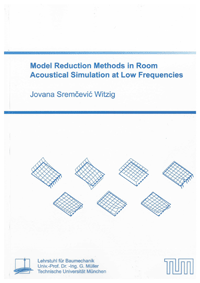
Shop : Details
Shop
Details

May 2012
Jovana Sremcevic Witzig
Model Reduction Methods in Room Acoustical Simulation at Low Frequencies
In everyday engineering practice the problem of predicting the vibrational behavior of acoustical systems often occurs. Knowing the physical behavior of the systems is a prerequisite for providing a noise control and acoustic design.
Numerous methods are used in vibroacoustics for prediction of vibrations and induced sound fields. The choice of the appropriate method is influenced by the characteristics of the system and the frequency range of interest.
In this research the Finite Element Method is used for the room acoustical simulations. Numerical methods are convenient for detailed description of complex geometries and provide results with a spatial resolution of the sound field. They allow the calculation of the deterministic response of the system for deterministic load and defined model parameters. For higher frequencies, the reliability of this method might be significantly reduced due to discretization and also by the influence of small parameter variances. Moreover, numerical models for higher frequencies require a very fine discretization which leads to extensive calculations.
In the scope of this work the calculation effort in room acoustical simulations at Low Frequencies is reduced with the help of a model reduction method. The applied model reduction is based on the method of component mode synthesis. The acoustical system is divided into substructures and analyses are performed on the substructure level. In the approximated model of the whole system the substructures are represented with component modes. The necessary number of component modes for the approximation of the acoustic system is reduced by introducing Modal constraint modes or Modal attachment modes. The modal constraint and attachment modes describe the displacement pattern at the interface between the substructures.
This method is applied for coupling of two and more fluid substructures and for Fluid-Structure Interaction problems in 2- and 3-dimensions. The examples show that the approach with modal constraint and attachment modes has approximately the same exactness as the traditional Craig-Bampton method and therefore, it can be used for the approximation of the full FE model. This approach has given good results in coupling of several fluid substructures as well as in coupling of fluid and solid structures. Therefore, this method can be used for substructuring of complex geometries and in FSI problems. It has also been shown that the modal approach does not only give the good approximation of the FE model but it also can accelerate the calculation time significantly by reducing the number of unknowns.
Numerous methods are used in vibroacoustics for prediction of vibrations and induced sound fields. The choice of the appropriate method is influenced by the characteristics of the system and the frequency range of interest.
In this research the Finite Element Method is used for the room acoustical simulations. Numerical methods are convenient for detailed description of complex geometries and provide results with a spatial resolution of the sound field. They allow the calculation of the deterministic response of the system for deterministic load and defined model parameters. For higher frequencies, the reliability of this method might be significantly reduced due to discretization and also by the influence of small parameter variances. Moreover, numerical models for higher frequencies require a very fine discretization which leads to extensive calculations.
In the scope of this work the calculation effort in room acoustical simulations at Low Frequencies is reduced with the help of a model reduction method. The applied model reduction is based on the method of component mode synthesis. The acoustical system is divided into substructures and analyses are performed on the substructure level. In the approximated model of the whole system the substructures are represented with component modes. The necessary number of component modes for the approximation of the acoustic system is reduced by introducing Modal constraint modes or Modal attachment modes. The modal constraint and attachment modes describe the displacement pattern at the interface between the substructures.
This method is applied for coupling of two and more fluid substructures and for Fluid-Structure Interaction problems in 2- and 3-dimensions. The examples show that the approach with modal constraint and attachment modes has approximately the same exactness as the traditional Craig-Bampton method and therefore, it can be used for the approximation of the full FE model. This approach has given good results in coupling of several fluid substructures as well as in coupling of fluid and solid structures. Therefore, this method can be used for substructuring of complex geometries and in FSI problems. It has also been shown that the modal approach does not only give the good approximation of the FE model but it also can accelerate the calculation time significantly by reducing the number of unknowns.
Keywords: Model Reduction Methods; Component Mode Synthesis; Room Acoustics; Fluid-Structure Interaction
Schriftenreihe des Lehrstuhls für Baumechanik
Edited by Univ.-Prof. Dr.-Ing. G. Müller, München
Volume 9
Export of bibliographic data
Shaker Verlag GmbH
Am Langen Graben 15a
52353 Düren
Germany
Am Langen Graben 15a
52353 Düren
Germany
Mon. - Thurs. 8:00 a.m. to 4:00 p.m.
Fri. 8:00 a.m. to 3:00 p.m.
Fri. 8:00 a.m. to 3:00 p.m.
Contact us. We will be happy to help you.

